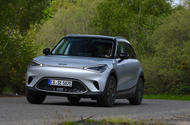
Early examples of Smart’s new dawn didn’t instantly impress. We try the EV hatchback on UK roads
Yes, it really is pronounced ‘hashtag one’. The silly name has a distinct whiff of middle-aged marketing people trying to be down with the kids. But don’t let that put you off, because the new Smart #1 is quite a good EV.We’ve previously gone into Smart’s transformation from maker of tiny but expensive city cars to mainstream EV brand, so here’s the short version: Mercedes-Benz realised after about two decades that Smart in its original form was likely never going to be profitable, so it set up a joint venture with Geely (the Chinese owner of Lotus, Polestar, Volvo and many more) to build cars in China using Geely technology but with plenty of European input.The first result is the #1, an electric hatchback with a footprint similar to that of the Volkswagen Golf but a bit taller to more easily accommodate the 62kWh (usable) battery pack. Larger models still, like the Smart #3 SUV, will follow soon.Standard #1 models have a single 268bhp rear motor, while the Smart #1 Brabus adds a 154bhp front motor for a total of 422bhp.The 273-mile quoted range for the mid-range single-motor Premium and the capability to charge at 150kW are more than competitive when compared with rivals such as the Cupra Born and Renault Mégane E-Tech Electric.At £35,950 for the well-equipped entry-level Pro+ and £38,950 for the even more complete Premium, it’s priced below most rivals, too, even if the MG 4 EV remains unbeatable in that area.When we drove early examples of the #1 in Spain back in September, the packaging impressed but the buggy screen and unfinished dynamics frustrated.A left-hand-drive production car made its way to the UK recently, and we will subject it to a group test with the Born and BYD Atto 3 in the 7 June magazine, but even in isolation it impressed a lot more than those on the international launch.That’s thanks in large part to a software update for the centre touchscreen. The busy, cartoonish graphics are still slightly overwhelming when you first boot it up, but with a few minutes of familiarisation, it all works very intuitively. Oft-used functions are rarely more than two taps away, the icons are decently large and respond instantly and the climate controls are always on screen.Two points of criticism remain, though: the cartoon fox is cute for about two minutes, but it can get distracting when it’s playing with its ball or dancing in your peripheral vision. Being an EU-market version, our test car also lacked Apple CarPlay or Android Auto. Spotify and a number of other services are built in, but Apple apps, Whatsapp and Waze aren’t. Smartphone integration will feature on UK cars from day one, but until then, we can’t test how well it works.The rest of the interior is very impressive indeed. The design of the rounded centre tunnel is very similar to that in recent Mercedes cars, and it has all manner of useful storage bins. Its satin, pearlescent white works with the standard panoramic roof to lend the interior a pleasant airiness.Everything is nicely made from mostly pleasing materials. The driving position has plenty of adjustment, but tall drivers will wish for a longer seat squab. The rear seat is comfortable for adults and can slide and recline. Although the 313-litre boot isn’t huge, there’s some extra space under its floor, as well as a small frunk that will swallow a charging cable.Don’t let the fact that the #1 is rear-wheel-drive fool you into thinking this is an exhilarating driver’s car. You will want a Born or 4 for that. Instead, the #1 is nicely balanced, with uncorrupted steering that’s geared medium-fast and has a reassuring weight to it, although no great deal of feedback.The excessive body roll we noted on the launch seems to have been banished, as has the shortage of grip, the latter thanks to the fitment of some Dunlop Sport Maxx tyres.The suspension is neither especially hard nor especially soft, and there’s good isolation from both noise and vibrations. It can feel a touch underdamped at times, but in general it’s really rather pleasant.With 268bhp, the #1 is quicker than most of its peers – fun though not transformative. However, I hope the accelerator calibration can still be tweaked before launch. The regen has three settings: Standard, Strong and e-Pedal, but even Standard is pretty strong, the pedal travel that controls the regen is very short and there’s a slight delay to the retardation kicking in.Over a few days with the car, it indicated energy efficiency of 3.5mpkWh, which is solid if not ground-breaking and translates to a real-world range of 220 miles.The #1 is a radically different car from any Smart that came before it and as such is a much less radical car. As electric hatchbacks go, it’s quite conventional but well-executed. The difficult-to-judge braking is an issue, and the smartphone integration is still an unknown, but apart from a few minor details, it’s well-priced, decent to drive and spacious and has very competitive range, charging and infotainment.
Source: Autocar